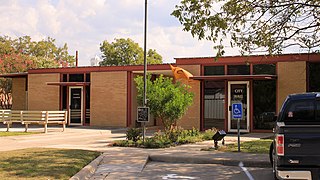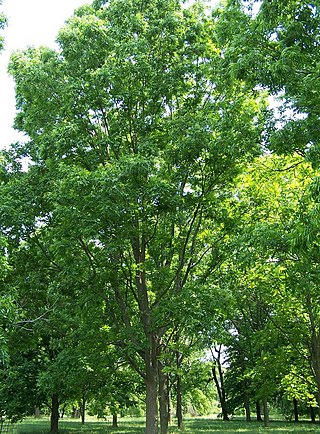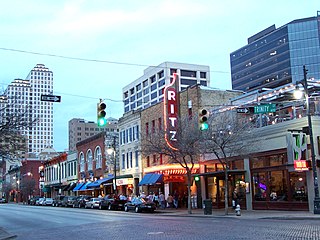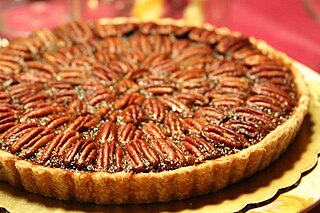Related Research Articles

San Saba is a city located in, and the county seat of, San Saba County, Texas, United States. It was settled in 1854 and named for its location on the San Saba River. Its population was 3,099 at the 2010 census.

Pecan Gap is a city in Delta and Fannin counties within the U.S. state of Texas. It is sometimes informally referred to as "The Gap" by area residents. The population was 178 at the time of the 2020 census. It is named for the gap between two pecan trees, but unfortunately one of the two pecan trees was destroyed by a tornado in 1963.

The pecan is a species of hickory native to the southern United States and northern Mexico in the region of the Mississippi River.

Pralines are confections containing nuts – usually almonds, pecans and hazelnuts – and sugar. Cream is a common third ingredient.

A nut is a fruit consisting of a hard or tough nutshell protecting a kernel which is usually edible. In general usage and in a culinary sense, a wide variety of dry seeds are called nuts, but in a botanical context "nut" implies that the shell does not open to release the seed (indehiscent).
Stuckey's is a convenience store in the Southeast, Southwest, and Midwestern United States. It is known for its pecan log rolls and kitschy souvenirs. Additionally, Stuckey's sells candy, apparel, souvenirs, and other products online.

Sixth Street is a historic street and entertainment district in Austin, Texas, located within the city's urban core in downtown Austin. Sixth Street was formerly named Pecan Street under Austin's older naming convention, which had east–west streets named after trees and north–south streets named after Texas rivers.

Pecan pie is a pie of pecan nuts mixed with a filling of eggs, butter, and sugar. Variations may include white or brown sugar, cane syrup, sugar syrup, molasses, maple syrup, or honey. It is commonly served at holiday meals in the United States and is considered a specialty of Southern U.S. origin. Most pecan pie recipes include salt and vanilla as flavorings. Pecan pie may be served with whipped cream, vanilla ice cream or hard sauce.
Pecan Park is a neighborhood in Houston, Texas.

Pecan oil is an edible pressed oil extracted from the pecan nut. Pecan oil is neutral in flavor and takes on the flavor of whatever seasoning is being used with it. Pecan oil contains 9.5% saturated fat, which is less than in olive oil (13.5%), peanut oil (16.90%) or corn oil (12.70%). It is also used as a massage oil and in aromatherapy applications.
The Institute of Living is a comprehensive psychiatric facility in Hartford, Connecticut, that offers care across the spectrum of psychiatric services, including crisis evaluation, inpatient psychiatric care, group homes, specialized educational programs, outpatient programs, and addiction recovery services.
The Pecan Bowl was the name of some December college football bowl games played in two different eras. In 1946 and 1947, the game was contested between historically black colleges and universities (HBCUs). From 1964 through 1970, the game was a regional final within the NCAA's College Division.

Cladosporium caryigenum is a synonym of Fusicladium effusum, the plant pathogen which causes pecan scab. Pecan scab is the most economically significant disease of pecan in the southeastern United States. In 2010, Seyran and colleagues used sequencing of the mitochondrial gene for cytochrome b to conclusively classify the pecan scab fungus as Fusicladium effusum.
Meloidogyne partityla is a plant pathogenic nematode infecting pecan. One of the first described cases of this nematode where noted in pecan trees in South Africa by Brito et al. (2013). It is thought to have been introduced into South Africa by pecan seedlings that came from the United States. Today, this nematode is seen infecting pecan trees in Arizona, Arkansas, Florida, Georgia, New Mexico, Oklahoma, and Texas. They not only infect pecans, but they also infect the California black walnut, English walnut, shagbark hickory, and laurel oak. The first report in the US, was reported in South Carolina in which it infected laurel oaks but later started infecting neighboring pecan trees in the shared orchards. The health of infested trees continue to decline every year.

Butter pecan is a flavor, prominent especially in the United States, in ice cream, cakes, and cookies. Roasted pecans, butter, and vanilla flavor are used in butter pecan baked goods. Butter pecan ice cream is smooth vanilla ice cream with a slight buttery flavor, with pecans added. It is manufactured by many major ice cream brands. A variant of the recipe is butter almond, which replaces the pecans with almonds.
Pecan anthracnose is a fungal disease of pecan trees caused by the ascomycete Glomerella cingulata (Stoneman) Spauld. & H. It is a widespread disease found wherever pecan trees are grown. Pecan anthracnose has been reported as far back in time as 1914, and as far away as Argentina. Glomerella cingulata has two anamorphs which cause disease on pecan trees, Colletotrichum gloeosporioides and Colletotrichum acutatum. The occurrence of Colletotrichum on pecans has contributed to a significant decline in pecan production in various years. An increase in the incidence of pecan anthracnose is highly correlated with heavy rainfall, especially heavy rainfall occurring in early spring. The severity of symptoms increases as the season progresses, often culminating in leaf drop in the late autumn. This defoliation is linked to lower yield and poorer quality of nuts.

Pecan scab is the most economically significant disease of pecan trees in the southeastern United States. Venturia effusa is a fungal plant pathogen that causes pecan scab. The fungus causes lesions and tissue death on pecan twigs, petioles, leaves, nuts and shucks beginning in early spring, with multiple cycles of infection repeating until late summer. Wind and rain spread the fungus to a susceptible host. Control of the disease is achieved by fungicide, sanitation and, in some cases, quarantine.
The Elliot Pecan, or Elliott Pecan, is a pecan variety planted predominantly in Georgia and Florida. The nut is distinguishable by its smooth shell and small, tear-drop shape. The first Elliot tree was a seedling in the lawn of the American lumberman Henry Elliot in Milton, Florida. The Elliot Pecan tree is among the most disease-resistant pecan trees planted in the Southeastern United States.
The 1965 NCAA College Division football season was the tenth season of college football in the United States organized by the National Collegiate Athletic Association at the NCAA College Division level.
Pecan bacterial leaf scorch is a disease of the pecan tree that is common throughout the production regions of the United States caused by the pathogenic bacterium Xylella fastidiosa subsp. multiplex. The pathogen was initially discovered to be coincidentally associated with symptoms of pecan fungal leaf scorch in 1998 and has subsequently been found to be endemic in the southeastern United States, as well as Arizona, California, and New Mexico.